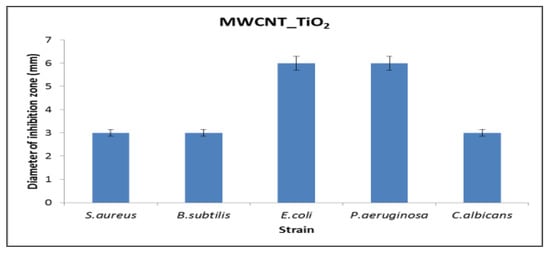Worldwide, one of the most significant threats to human health problems remains antibiotic resistance. In the last several years, bacteria have evolved in order to survive antimicrobial treatments by effectively developing resistance mechanisms []. It has been shown that nanoparticles and nanotubes have outstanding antimicrobial activity due to the increased contact area with bacteria []. The aim of this study was to design and characterize hybrid materials composed by multi-walled carbon nanotubes (MWCNTs) decorated with TiO2 nanoparticles, in order to obtain an efficient nanosystem with improved antimicrobial activity by a fast and low-cost method. The carbon nanotubes used in this study were obtained by chemical synthesis [] and used as a template for TiO2 nanoparticles formation. The nanocomposites (MWCNTs_TiO2) were obtained by TiO2 in situ attachment on the surface of MWCNTs, by using a titanium (IV) isopropoxide precursor. The obtained hybrid nanomaterials were further characterized by Raman Spectroscopy Analysis, X-ray Diffraction Analysis (XRD), and Transmission Electron Microscopy (TEM). The antimicrobial activity of MWCNTs_TiO2 was investigated against two Gram-positive (Staphylococcus aureus, Bacillus subtilis), two Gram-negative (Pseudomonas aeruginosa, Escherichia coli) and one yeast (Candida albicans) to cover the most important model opportunistic pathogens. TEM micrographs revealed that the MWCNTs have a diameter between 9 and 50 nm and a length of 600 nm and TiO2 nanoparticles with a diameter of about 15 nm were successful deposited on the nanotubes surface. Qualitative testing of antimicrobial activity demonstrated that MWCNT_TiO2 were able to inhibit growth for all tested strains, mostly in the case of the Gram-negative bacteria (E. coli and P. aeruginosa). Quantitative tests showed that the obtained nanocomposites have more pronounced antimicrobial effects on Gram-negative bacteria compared to the yeast or Gram-positive bacteria. This can be explained with the particularities of the cellular wall of each type of bacteria, Gram-negative bacteria have a thin peptidoglycan layer and an outer lipid membrane, which make the bacteria easier to inhibit and leads to a faster destructibility of the cell membrane. The decoration of MWCNTs with TiO2 nanoparticles has been successful carry out, spherical nanoparticles with a diameter about 15 nm being attached to the nanotubes surface. The obtained nanocomposites presented more pronounced antimicrobial activity on Gram-negative bacteria. The obtained results sustained that the synthetized nanocomposites can be considered as competitive candidates for the development of efficient antimicrobial systems (Figure 1).

Figure 1.
Diameter of inhibition zone for the obtained nanocomposite.
Funding
This work was supported by a grant of the Romanian Ministry of Research and Innovation, CCCDI—UEFISCDI, project number PN-III-P1-1.2-PCCDI-2017-0476/51PCCDI/2018, within PNCDI III and PN.19.23.03.01 contract no. 23N/2019 within the NUCLEU Program.
Institutional Review Board Statement
Not applicable.
Informed Consent Statement
Not applicable.
Data Availability Statement
Not applicable.
Conflicts of Interest
The authors declare no conflict of interest.
References
- Grigore, M.E.; Grumezescu, A.M.; Holban, A.M.; Mogoşanu, G.D.; Andronescu, E. Collagen-nanoparticles composites for wound healing and infection control. Metals 2017, 7, 516. [Google Scholar] [CrossRef] [Green Version]
- David, M.; Ion, R.-M.; Grigorescu, R.M.; Iancu, L.; Holban, A.; Nicoara, A.; Alexandrescu, E.; Somoghi, R.; Ganciarov, M.; Vasilievici, G.; et al. Hybrid Materials Based on Multi-Walled Carbon Nanotubes and Nanoparticles with Antimicrobial Properties. Nanomaterials 2021, 11, 1415. [Google Scholar] [CrossRef] [PubMed]
- David, M.E.; Grigorescu, R.M.; Iancu, L.; Andrei, E.R.; Somoghi, R.; Frone, A.N.; Atkinson, I.; Predoana, L.; Nicoara, A.-I.; Ion, R.-M. Synthesis and characterization of multi-walled carbon nanotubes decorated with hydroxyapatite. Full-Nanotub. Carbon Nanostruct. 2021, 29, 423–430. [Google Scholar] [CrossRef]
Publisher’s Note: MDPI stays neutral with regard to jurisdictional claims in published maps and institutional affiliations. |
© 2022 by the authors. Licensee MDPI, Basel, Switzerland. This article is an open access article distributed under the terms and conditions of the Creative Commons Attribution (CC BY) license (https://creativecommons.org/licenses/by/4.0/).